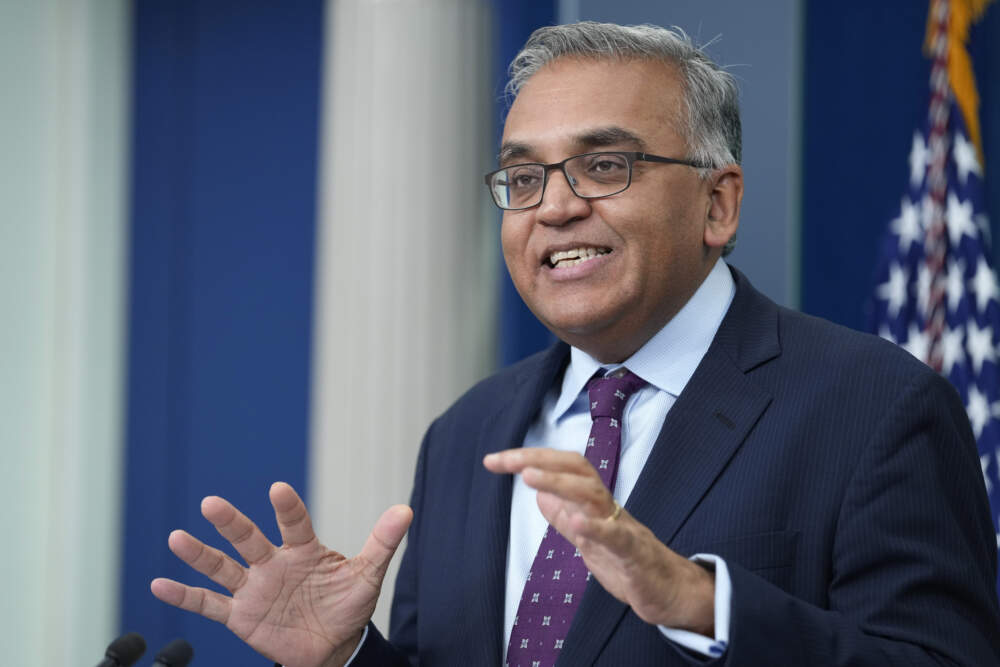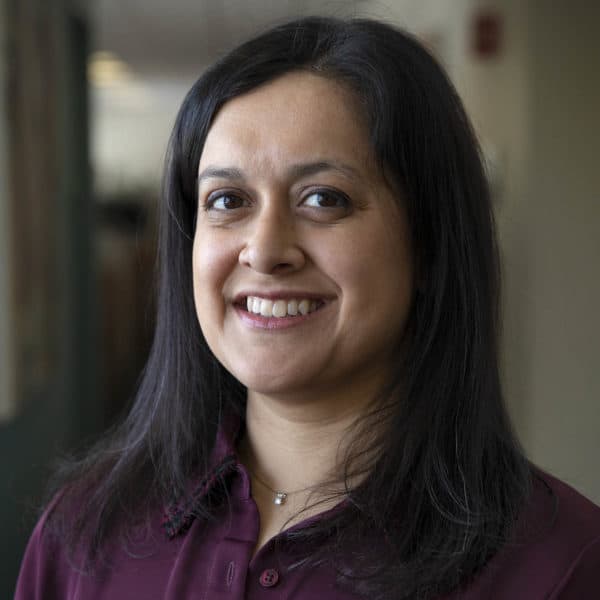Advertisement
Coronavirus Coverage
Q&A: Ashish Jha on the coming virus season and what he learned in the White House

COVID is on the upswing, and the annual fall respiratory virus season is on the horizon. So, what should we expect from some of the most common infectious diseases in the next few months?
WBUR reached out to Dr. Ashish Jha, dean of Brown University’s School of Public Health, to understand the coming virus season, and how vaccines could help to reduce the risk of illness.
Jha has become one of the country’s most familiar COVID experts, and he recently finished a stint as White House COVID-19 response coordinator.
While viruses sicken and kill thousands of patients every fall and winter, Jha said many hospitalizations and deaths can be prevented if everyone eligible for the COVID, flu and RSV vaccines gets them. He also reflected on his time at the White House, coordinating the fight against COVID.
This interview has been edited and condensed for clarity:
How are you thinking about the fall and winter months ahead — both the threats we're facing, and the tools that we have to manage them?
Jha: Fall respiratory season is always bad in the sense that a lot of people get infected, a lot of people end up getting seriously ill and dying. Before COVID arrived, in a typical fall and winter season, probably fifty, sixty thousand Americans died every year. With the addition of COVID — even though COVID is in a much, much better place than where it was — we are probably at a point where more than a hundred thousand Americans are going to die each fall and winter for a long period of time, unless we do something about it.
The good news is we now have three highly effective vaccines that can prevent a large chunk of those deaths. So when I think about the fall ahead, I'm really looking at a period where there could be a lot of serious illness, a lot of suffering — but so much of it is preventable.
So how significant is the new COVID vaccine?
Jha: I think it's a game-changer in a couple of ways. Every year, we formulate a new flu vaccine based on circulating flu strains. We're now into a period when we're doing essentially the same thing with COVID vaccines: We're looking at the circulating strains. And the data so far suggests that the new COVID vaccine should be very effective against the circulating strains.
We're getting into a new cadence now where we're going to have annual COVID vaccines, and it becomes in that way very much like flu — very manageable.
What's your recommendation on when to get these vaccines? Usually, the flu shot is given in October. The new COVID shots are starting to become available now.
Jha: For low-risk people — young people, healthy people — they should get the shots whenever it's convenient. Just get it done and over with. And that's because they're going to get a robust immune response, and that will carry them throughout the winter season. Flu doesn't peak until February, but for young healthy people, getting it now should be good.
For older people, there's a little bit less of a robust immune response. They're at much higher risk as well. So my general advice has been, get the COVID and flu shots together, but get them in October. Because it just gives you a bit more protection by the time we get to January and February.
So where does RSV fit into this mix?
Jha: RSV is now a bit of a game-changer because it's the third vaccine. It’s only authorized for the highest-risk people: people over 60, pregnant women. RSV also has a lot of variability, but to the extent that we can predict, it tends to come early in the season.
With my elderly parents, I told them to get the RSV vaccine as soon as it became available. If you want to get all three shots at once, you can do that. If you don't mind spacing it out, getting the RSV shot now and getting COVID and flu shots in October is reasonable.
You do not want to get into November without these three shots, because your risk of getting infected and getting very sick starts climbing pretty quickly.
Last year, a lot of kids with RSV were hospitalized, including newborn babies. Any idea what to expect with RSV this year? Are we settling into a more seasonal pattern, or is it too soon to tell?
Jha: Timing can vary from year to year. With the pandemic, there are some interplays across viruses that when one peaks, that can suppress some of the other viruses. And then we had a period of a couple of years where there was a lot of mask-wearing and a lot of people not getting infected.
So I think we’re still kind of settling into a new normal. I have every reason to believe that RSV will come back again this winter, as it does every winter. RSV tends to peak a little earlier than flu and COVID, so we may see an early RSV season. But we'll just have to track this very carefully and see where it goes.
What kind of demand are you expecting to see for each of these vaccines? Are you hopeful that COVID shots will become part of the annual fall ritual?
Jha: I hope so. I really hope that what we see is people getting into a routine where they get their fall COVID and flu shots, and they know that that dramatically reduces their risk of getting significantly ill.
What about other behavior changes, things other than vaccines? Do you recommend people think about wearing masks again? Do you expect to see more hospitals put their mask policies back in place?
Jha: Masks can be very helpful, particularly for COVID, probably for flu and RSV as well. Then there's a question of: Do you recommend that people wear masks all through the fall and winter? Well, that's a six-month time period. I think that's both unrealistic and unnecessary.
When infection numbers are up, I can imagine a lot of health care systems saying: We're going to ask people to wear a mask for a period of time. I can imagine that if a community is having a really large outbreak, community leaders will come out and say: For the next four weeks, we want people wearing masks indoors. I think that would be a reasonable strategy.
This is something that got a lot of criticism because it probably wasn't super helpful for COVID, but it is more helpful for flu, and that's washing hands. It turns out that while COVID is airborne, flu can very much spread through surfaces, and so cleaning surfaces, washing hands, actually can dramatically reduce the risk of getting infected.
I've been asking you about fall and winter, but we are still in this late-summer COVID bump. So how are you thinking about that?
Jha: COVID has continued to surprise us. There tends to be three to four months as waves come down, and the new ones begin building again. So if you do the math, if things start coming down in September, they might go back up in December, January.
What do you miss most about working at the White House?
Jha: I will tell you, I am thrilled to be back at home. So I don't know that I'm missing a lot. Obviously, it's an extraordinary place to work. Huge privilege. I was very, very happy to be there, but I went in there with a very specific set of goals, and I feel like we hit those goals. And I was happy to thank the president for the opportunity to serve, and leave.
Was there a certain moment when you felt like you helped accomplish something for the nation?
Jha: I went in the spring of ‘22 and had several goals. I wanted us to get through a winter without our health care system getting into big trouble the way it had the two previous winters. I wanted to start setting up a cadence for what long-term management of this virus needs to look like. Obviously, it was really critical to end the public health emergency, and to do it in a responsible way so that the things that really matter to people — access to vaccines and treatments — don't go away.
As we hit those goals, I really felt like, OK, we're at a point where it can now be managed in a more regular order of business, that it doesn't need someone at the White House coordinating and driving it in the way that it did two years ago.
Is there something from that experience that you're bringing back to your work in public health and academia?
Jha: Absolutely. The biggest thing in my mind is a reminder of what a big and diverse and complicated country we have. And that in order to move policy, you've got to be able to reach out and engage with people with very different perspectives.
There are a lot of people who purport to be in public health who are very purist in their thinking about what the right thing to do is. And you realize, that is a formula for accomplishing nothing. So part of what I want to try to teach students is: How do you actually move the needle? How do you actually make progress in a country where people have different values? How do you build a coalition of people who don't have to agree on every single issue — but agree enough to really advance public health?
You’ve sometimes been criticized for your advice. How have you managed to keep your cool all this time? Are there days you just don’t want to pick up the phone?
Jha: For a public health person, feeling like you got to play a helpful role in the worst public health crisis in a century — this feels like a huge privilege. It felt like that before I went to the White House, it certainly felt like that at the White House, it continues to feel that way. This is why we train — so that if there is a crisis, we can play a helpful role. So I think that keeps me going.
